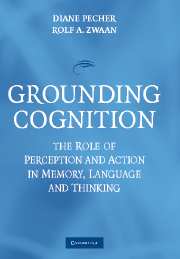Book contents
- Frontmatter
- Contents
- List of Contributors
- 1 Introduction to Grounding Cognition: The Role of Perception and Action in Memory, Language, and Thinking
- 2 Object Concepts and Action
- 3 Constraints on Spatial Language Comprehension: Function and Geometry
- 4 Embodiment in Metaphorical Imagination
- 5 Passionate Thoughts: The Emotional Embodiment of Moral Concepts
- 6 Grounding Language in Bodily States: The Case for Emotion
- 7 Situating Abstract Concepts
- 8 Dynamicity, Fictivity, and Scanning: The Imaginative Basis of Logic and Linguistic Meaning
- 9 The Emergence of Grammar from Perspective
- 10 Embodied Sentence Comprehension
- 11 On the Perceptual-Motor and Image-Schematic Infrastructure of Language
- 12 Connecting Concepts to Each Other and the World
- Author Index
- Subject Index
- References
1 - Introduction to Grounding Cognition: The Role of Perception and Action in Memory, Language, and Thinking
Published online by Cambridge University Press: 22 July 2009
- Frontmatter
- Contents
- List of Contributors
- 1 Introduction to Grounding Cognition: The Role of Perception and Action in Memory, Language, and Thinking
- 2 Object Concepts and Action
- 3 Constraints on Spatial Language Comprehension: Function and Geometry
- 4 Embodiment in Metaphorical Imagination
- 5 Passionate Thoughts: The Emotional Embodiment of Moral Concepts
- 6 Grounding Language in Bodily States: The Case for Emotion
- 7 Situating Abstract Concepts
- 8 Dynamicity, Fictivity, and Scanning: The Imaginative Basis of Logic and Linguistic Meaning
- 9 The Emergence of Grammar from Perspective
- 10 Embodied Sentence Comprehension
- 11 On the Perceptual-Motor and Image-Schematic Infrastructure of Language
- 12 Connecting Concepts to Each Other and the World
- Author Index
- Subject Index
- References
Summary
Fifty years of research in cognitive science have demonstrated that the study of cognition is essential for a scientific understanding of human behavior. A growing number of researchers in the field are proposing that mental processes such as remembering, thinking, and understanding language are based on the physical interactions that people have with their environment. Rather than viewing the body as a support system for a mind that needs to be fueled and transported, they view the mind as a support system that facilitates the functioning of the body. By shifting the basis for mental behavior toward the body, these researchers assume that mental processes are supported by the same processes that are used for physical interactions, that is, for perception and action. Cognitive structures develop from perception and action.
To fully understand why this idea is so exciting, we need to look at the history of cognitive science. One of the major ideas propelling the cognitive revolution was the computer metaphor, in which cognitive processes are likened to software computations (Turing, 1950). Just like software can run on different hardware systems, so can cognitive processes run independently from the hardware in which they happened to be implemented, the human brain and body. Furthermore, just as computer programs, the human mind was thought to manipulate abstract symbols in a rule-based manner. These symbols were abstract because they were not derived from interactions with the environment by way of sensory organs and effectors.
Information
- Type
- Chapter
- Information
- Grounding CognitionThe Role of Perception and Action in Memory, Language, and Thinking, pp. 1 - 7Publisher: Cambridge University PressPrint publication year: 2005
References
Accessibility standard: Unknown
Why this information is here
This section outlines the accessibility features of this content - including support for screen readers, full keyboard navigation and high-contrast display options. This may not be relevant for you.Accessibility Information
- 11
- Cited by
